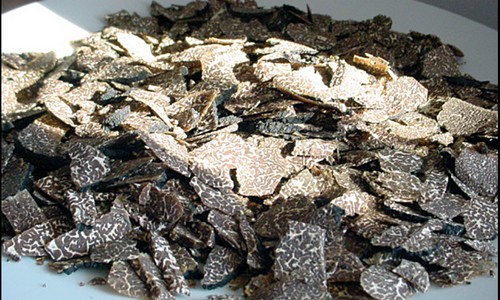Prodotti Tradizionali della Campania
TARTUFO NERO DI COLLIANO

Questo preziosissimo tartufo nero cresce sotto terra nei faggeti e nei e querceti del comprensorio dell’Alto Sele, nel Salernitano, e precisamente nei territori di Colliano, al cui nome è legato, Valva e Laviano, tra gli 800 e i 1500 metri sul livello del mare, in simbiosi, oltre che con querce e faggi, con carpini, olmi, aceri e noccioli, in terreni poveri di calcare e ricchi di humus. La sua dimensione varia da quella di una noce a quella di un uovo di gallina, la sua forma è regolare e presenta una fossetta centrale. La parte esterna, il peridio, è nero e rugoso con verruche di media grandezza, mentre la parte interna è di colore giallastro o bruno, con venature chiare, ed è caratterizzato da un profumo fortissimo. Matura da ottobre ad aprile, periodo nel quale inizia la raccolta, che avviene grazie all’istinto e alla capacità olfattiva di cani addestrati al fiuto del tartufo, alla ricerca, e ad obbedire al suo padrone, tartufaro. I cani con il naso appoggiato al terreno, lo percorrono in lungo e in largo fino ad individuare l’esatta ubicazione del corpo fruttifero. Individuato il punto, inizia lo scavo ed il tartufaro, che segue attentamente i vari movimenti, interviene con un piccolo attrezzo a manico corto a forma di piccone, aiutando il cane nello scavo per non fargli rovinare il frutto con le unghie e per non affaticarlo. Estratto il tartufo, il tartufaro ricolma subito la buca aperta con la terra scavata; questa è l’operazione più importante per la conservazione dello stato produttivo della tartufaia.
![]() This very precious black truffle grows underground in beechwood and oak tree forests in the Upper Sele, in the province of Salerno and precisely in the areas around Colliano to whose name it is linked, Valva and Laviano, It grows at rather high quotes starting in the 800s up to 1500 meters above the sea level, in symbiosis, with oak and beechwood trees, also with carpine, elm, maple and hazelnut trees, in soils poor of lime and rich in humus. Its dimension can change from that of walnut to a chicken egg, it has a regular shape and has a central dimple. The external part, the peridum, is black and wrinkly with medium size veins, while the internal part is of a yellowish or brownish colour with clear tinges and it has a very strong scent. It matures between October and April, when the harvest starts, the truffle are found exploiting the instinct and olphattive capacity of dogs trained in being able to sniff the truffle, research it and to respond to the truffle collector commands. The dogs with its nose to the ground, go all over the place until it can find the exact spot the tuber is. Once spotted, it starts digging and its owner who is observing every move, intervenes with a short-handle tool shaped like a pick, helping the dog dig to prevent the fruit from being ruined with the nails dog and also to avoid straining the dog. Once the truffle is extracted, the truffle collector fills the hole up again with the dug out soil; this is a very important operation for the preservation of the productive state of the truffle ground.
This very precious black truffle grows underground in beechwood and oak tree forests in the Upper Sele, in the province of Salerno and precisely in the areas around Colliano to whose name it is linked, Valva and Laviano, It grows at rather high quotes starting in the 800s up to 1500 meters above the sea level, in symbiosis, with oak and beechwood trees, also with carpine, elm, maple and hazelnut trees, in soils poor of lime and rich in humus. Its dimension can change from that of walnut to a chicken egg, it has a regular shape and has a central dimple. The external part, the peridum, is black and wrinkly with medium size veins, while the internal part is of a yellowish or brownish colour with clear tinges and it has a very strong scent. It matures between October and April, when the harvest starts, the truffle are found exploiting the instinct and olphattive capacity of dogs trained in being able to sniff the truffle, research it and to respond to the truffle collector commands. The dogs with its nose to the ground, go all over the place until it can find the exact spot the tuber is. Once spotted, it starts digging and its owner who is observing every move, intervenes with a short-handle tool shaped like a pick, helping the dog dig to prevent the fruit from being ruined with the nails dog and also to avoid straining the dog. Once the truffle is extracted, the truffle collector fills the hole up again with the dug out soil; this is a very important operation for the preservation of the productive state of the truffle ground.